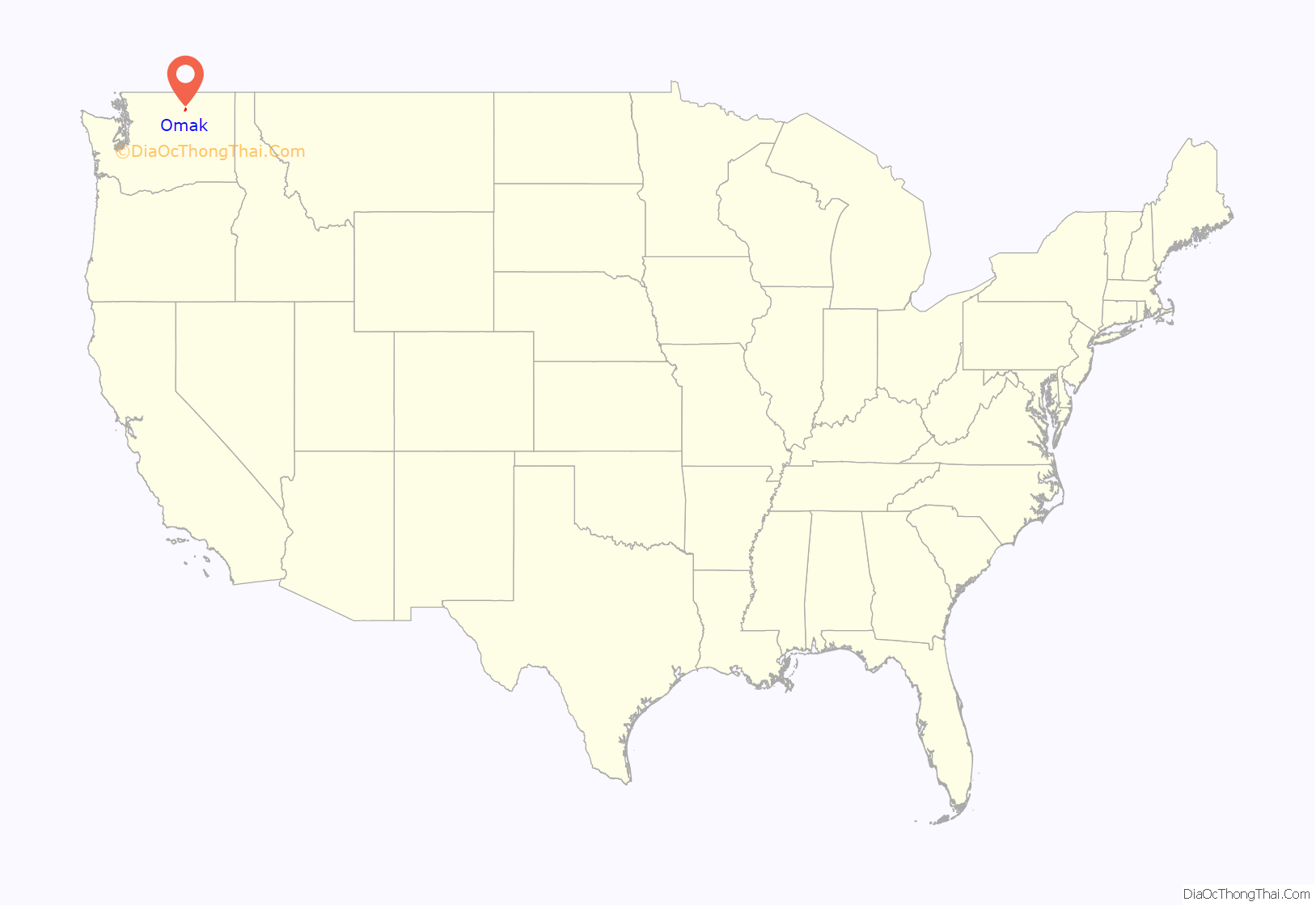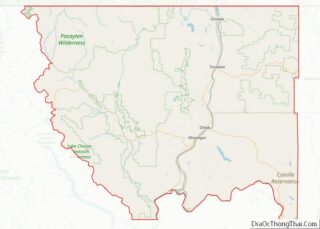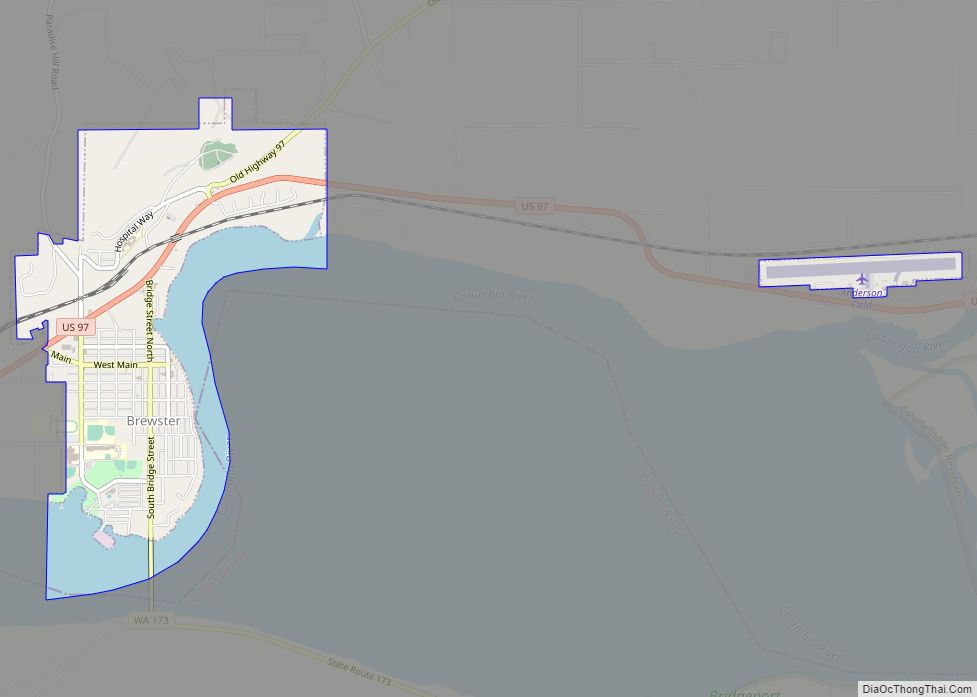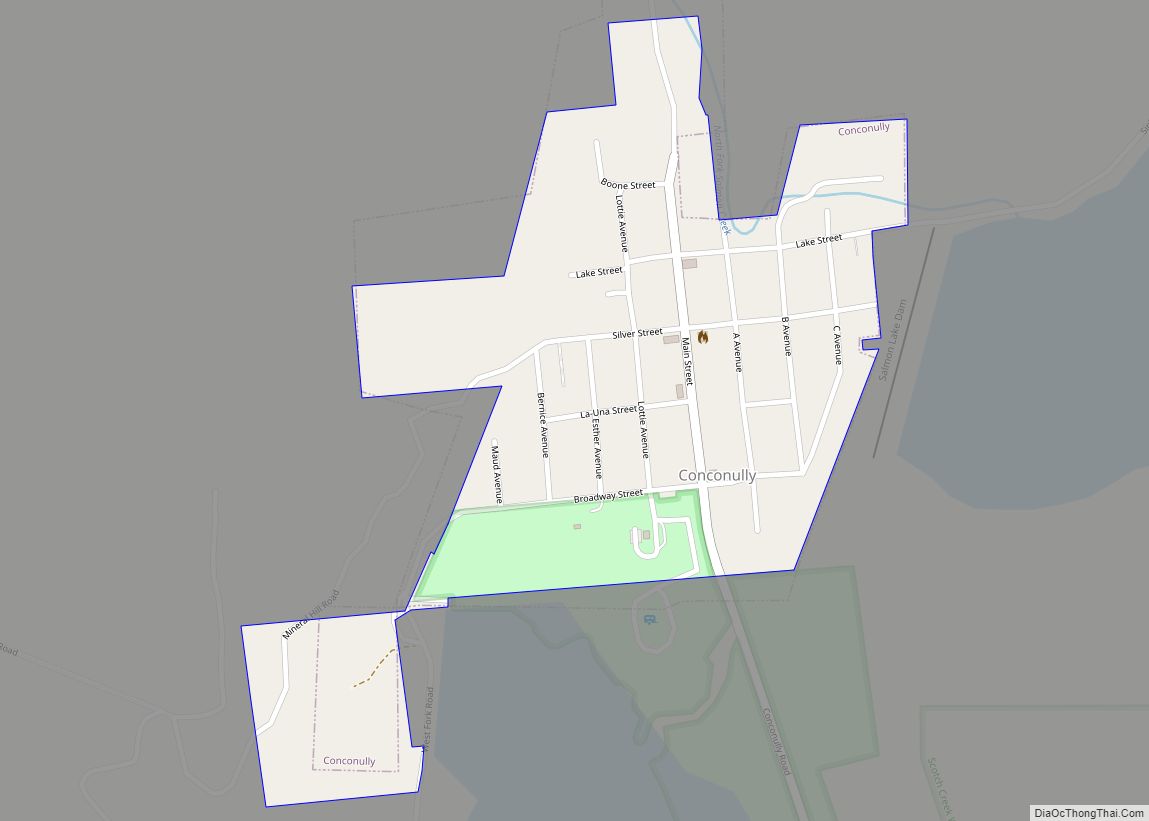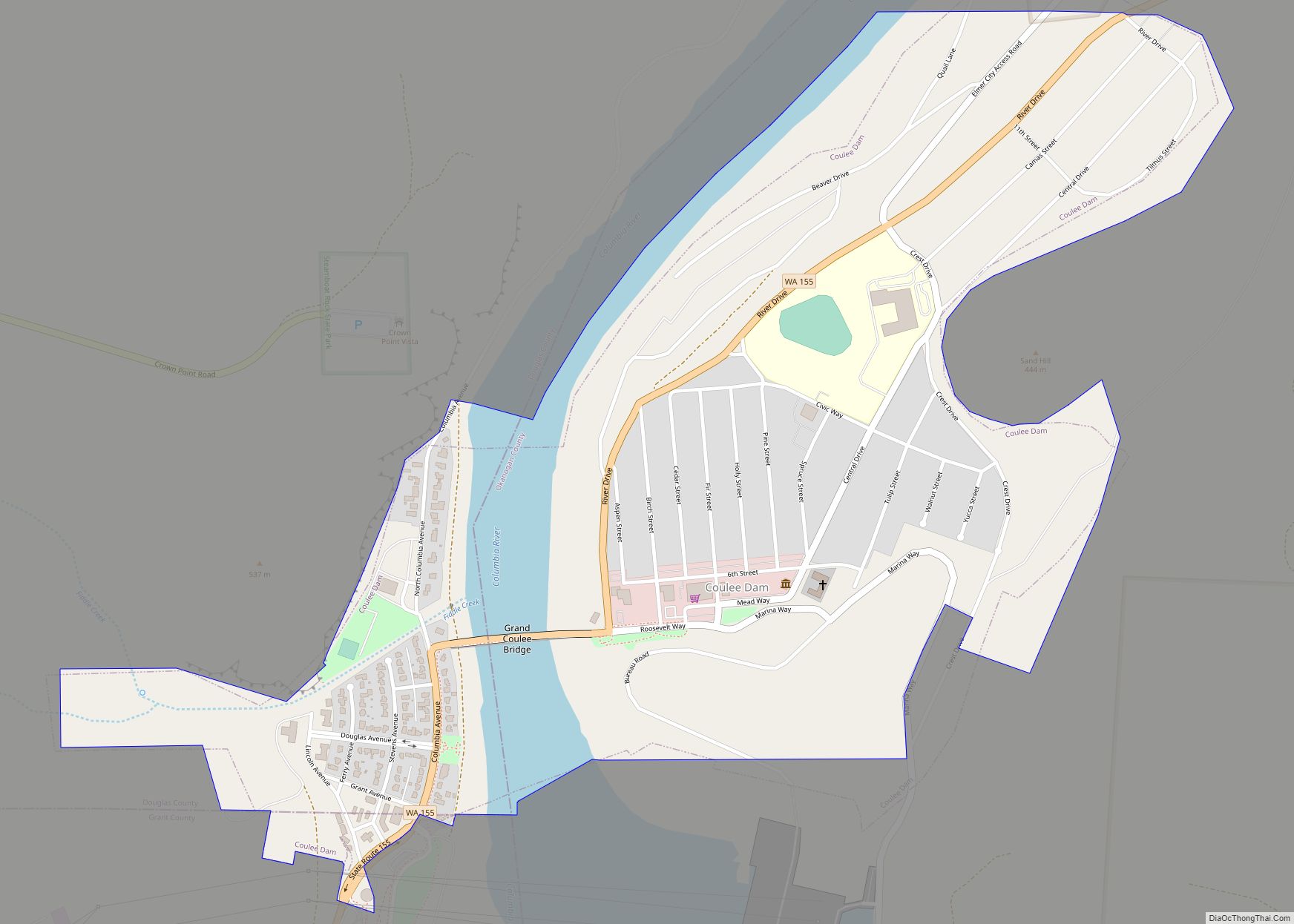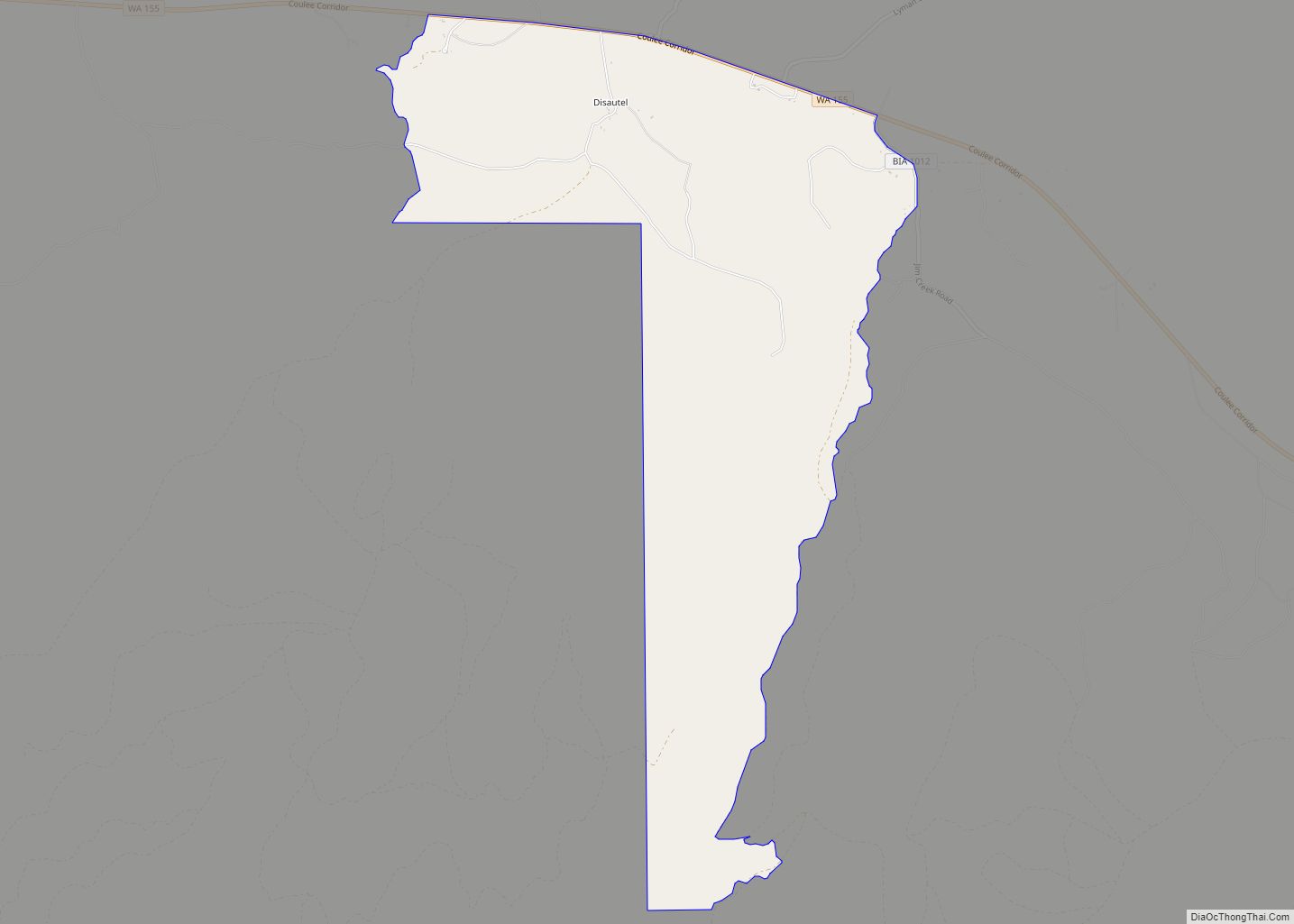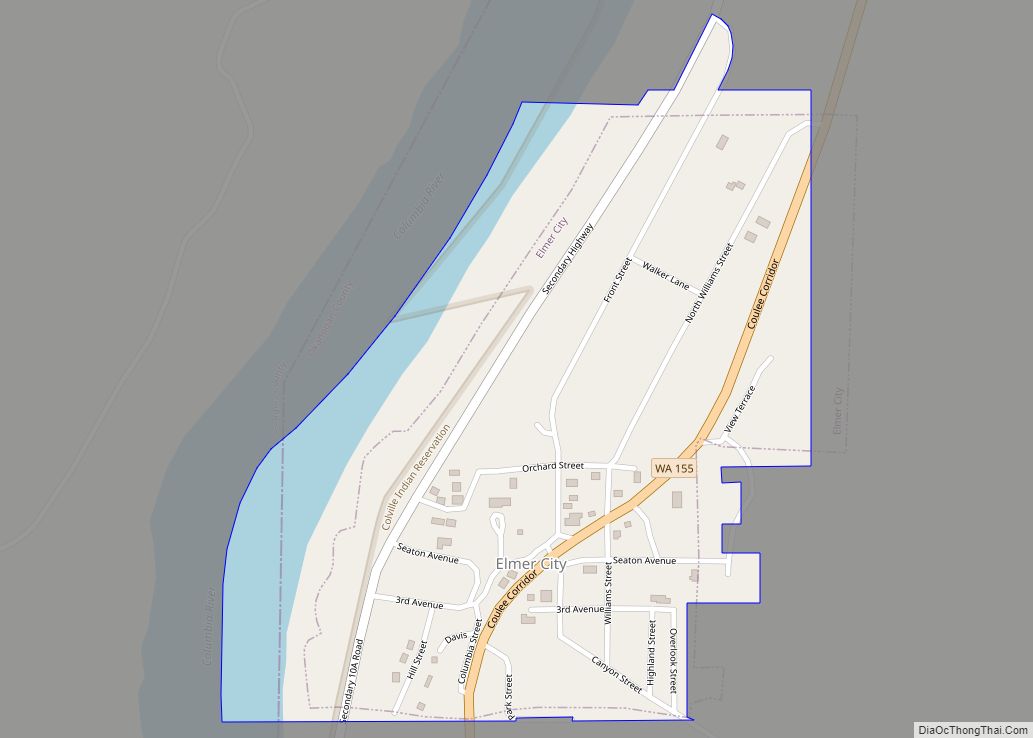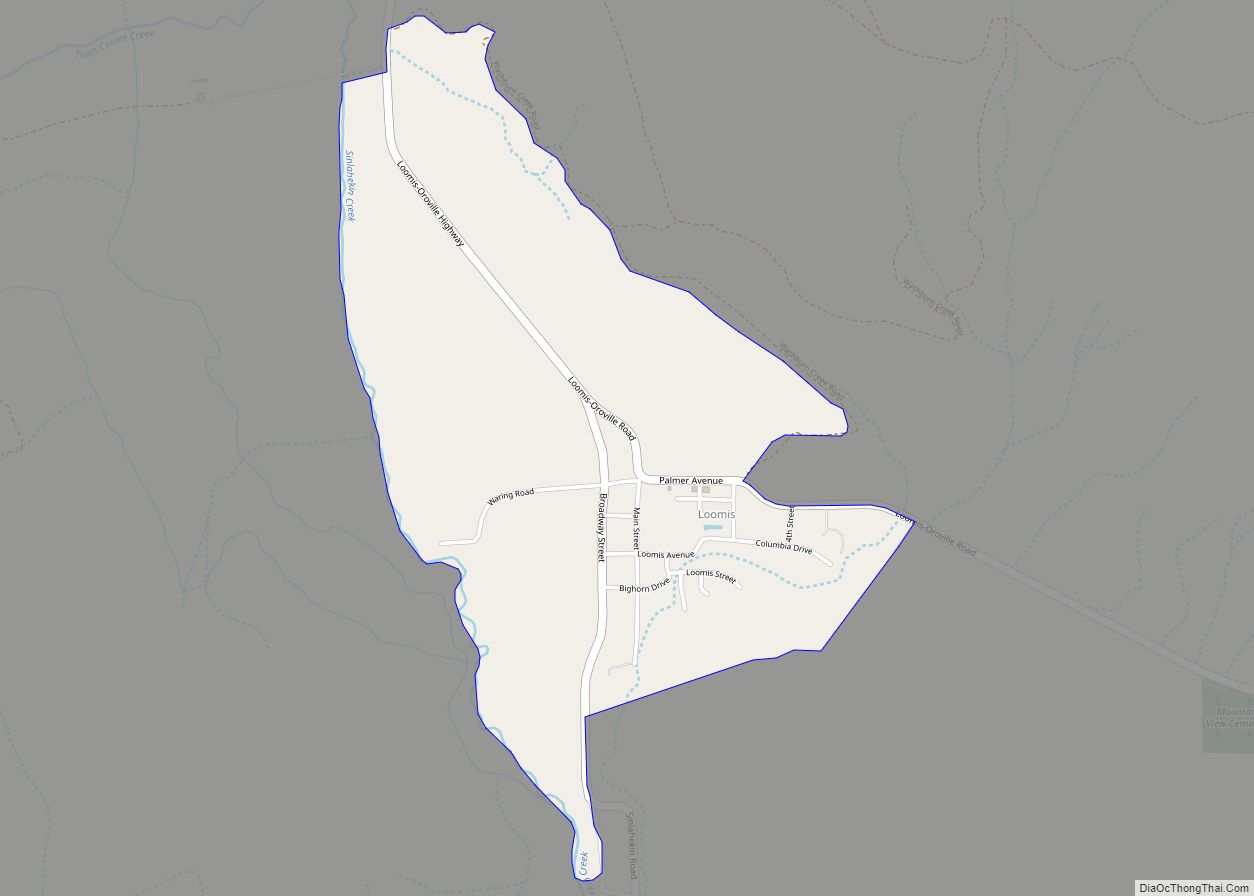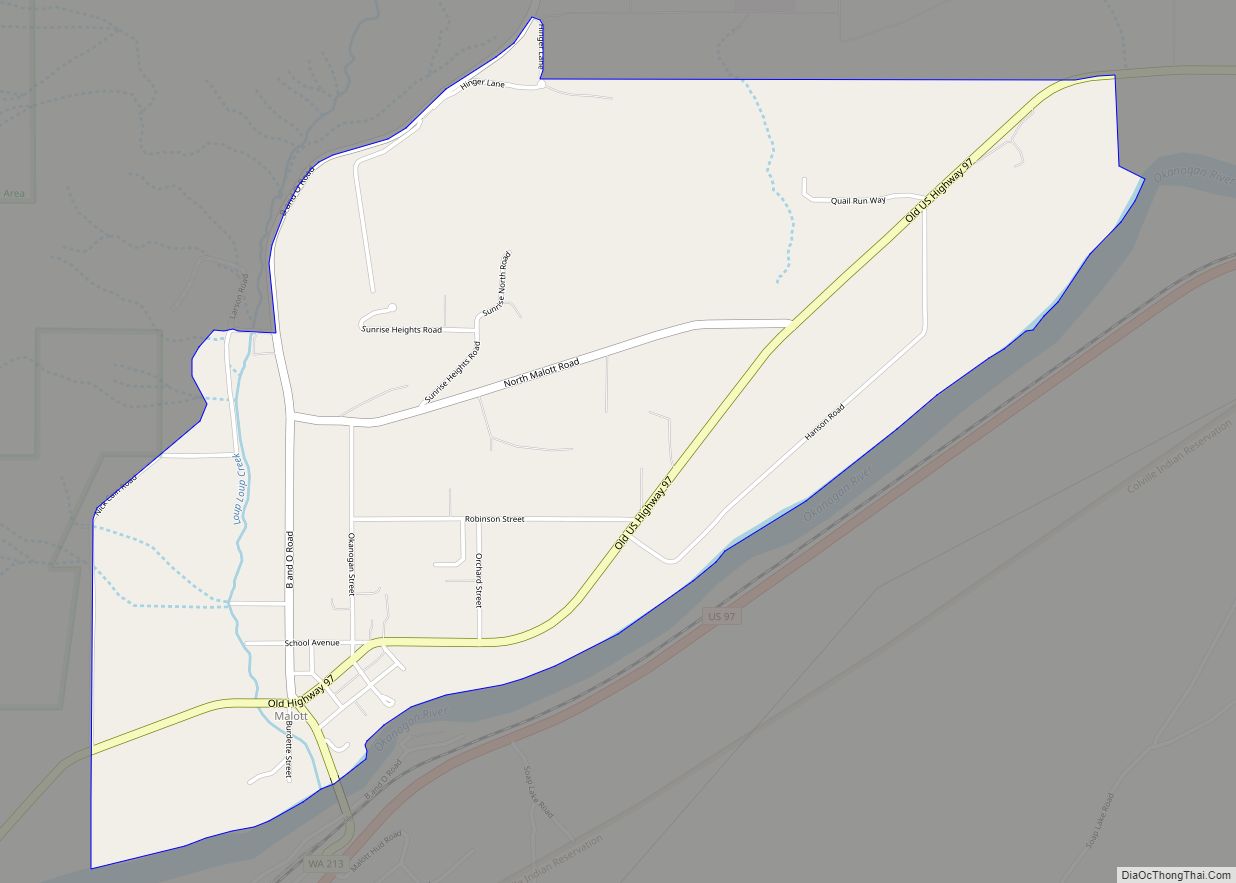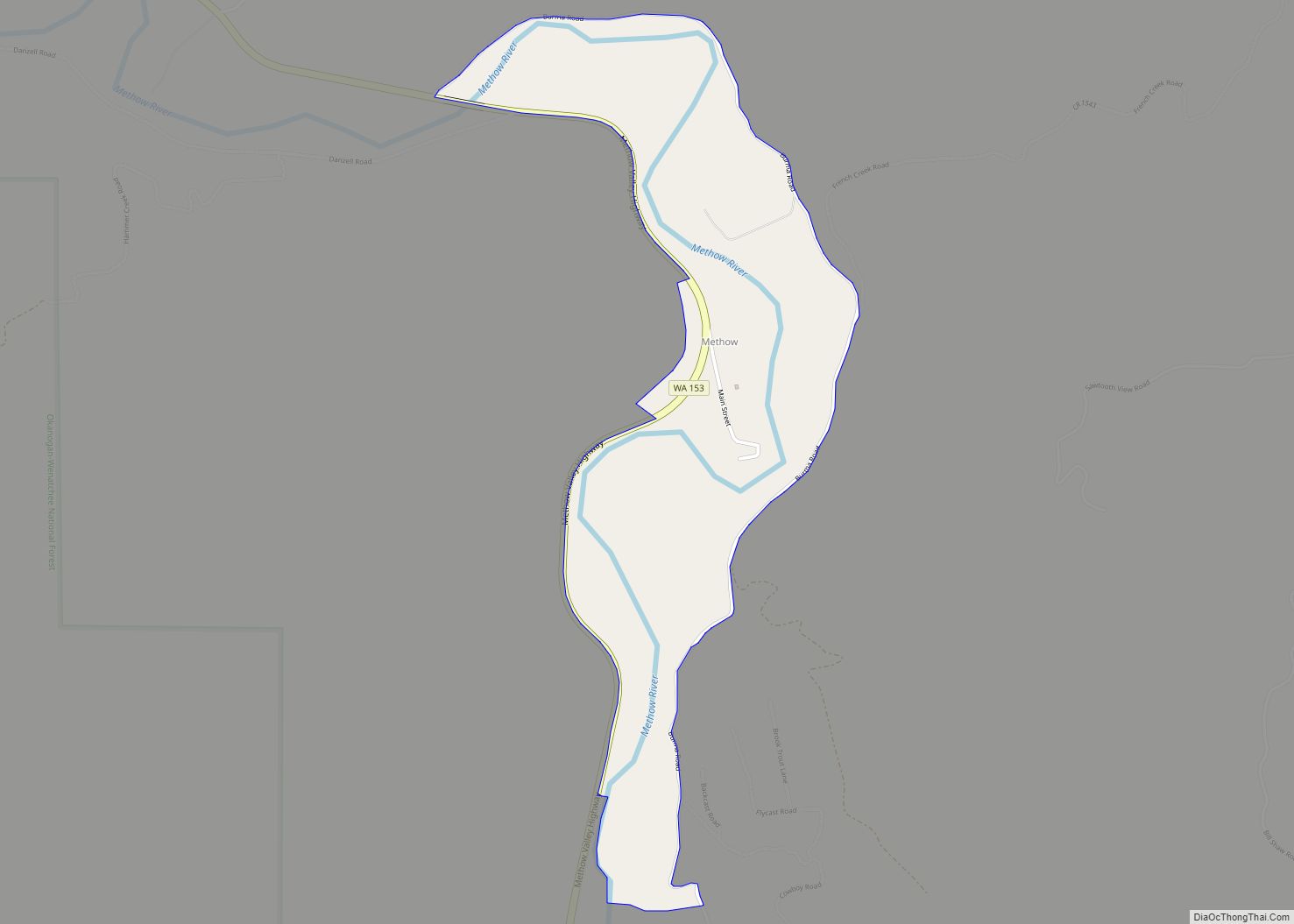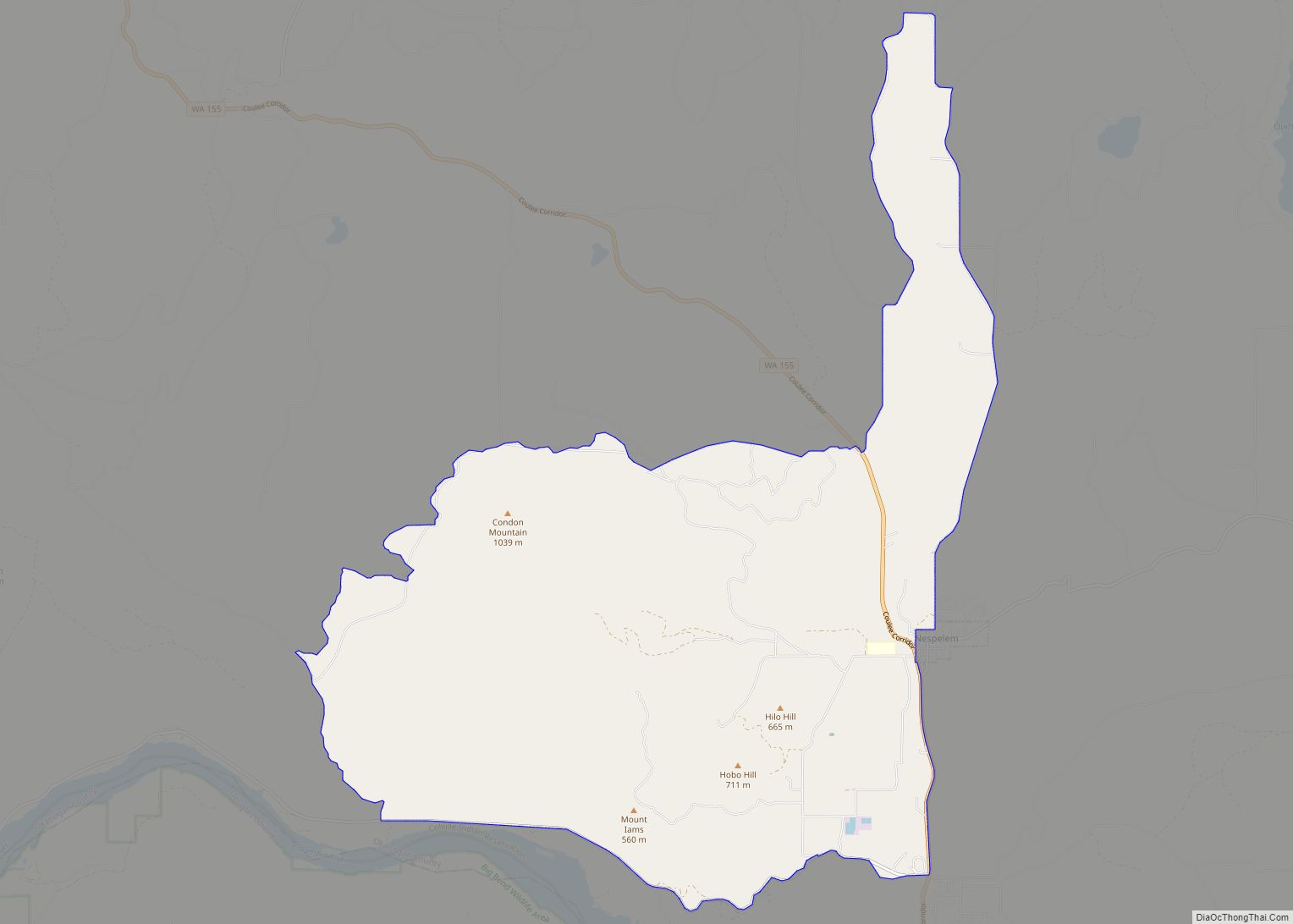Omak (/oʊˈmæk/ o-MAK) is a city located in the foothills of the Okanogan Highlands in north-central Washington, United States. With an estimated 4,845 residents as of 2010, distributed over a land area of 3.43 square miles (8.9 km), Omak is the largest municipality of Okanogan County and the largest municipality in Central Washington north of Wenatchee. The Greater Omak Area of around 8,229 inhabitants as of the 2010 census is the largest urban cluster in the Okanogan Country region, encompassing most of its twin city of Okanogan. The population has increased significantly since the 1910 census, reporting 520 residents just prior to incorporation in 1911.
The land that is now Omak had been inhabited by various Native American tribes before the arrival of non-indigenous settlers in the early 19th century. The city began to develop after the completion of the Okanogan Irrigation Project affecting the Grand Coulee Dam and other nearby electric facilities. The housing and municipal infrastructure, along with regional infrastructure connecting the new town to other municipalities, were built simultaneously in 1908 supported by the local agricultural industry. The name Omak comes from the Okanagan placename [umák], or the Salishan term Omache—which is said to mean “good medicine” or “plenty”, referring to its favorable climate, with an annual high of around 88 °F (31 °C). Omak acts as the gateway to the Okanogan–Wenatchee National Forest and consists of a central business district and residential neighborhoods.
Omak is a code city governed by a seven-member council and located in the state’s 4th congressional district. Omak’s economy is dominated by the primary sector industries of agriculture and forestry, although economic diversification has occurred with sawmills and recreational tourism. Nearby recreational destinations include walking trails, state parks and national forests, such as Conconully State Park, Bridgeport State Park and Osoyoos Lake State Park. The city is home to a weekly newspaper, the Omak–Okanogan County Chronicle, and a Wenatchee Valley College campus. Standards for education in Omak are higher than the state’s average, though drugs and alcohol remain a problem among students. U.S. Route 97 passes through the town, while Washington State Route 155, as well as Washington State Route 215, connects the city to Okanogan and Nespelem, respectively. By road, Omak is located approximately 235 miles (378 km) from Seattle, Washington, 140 miles (230 km) from Spokane, Washington and 125 miles (201 km) from Kelowna, British Columbia.
| Name: | Omak city |
|---|---|
| LSAD Code: | 25 |
| LSAD Description: | city (suffix) |
| State: | Washington |
| County: | Okanogan County |
| Incorporated: | February 11, 1911 |
| Elevation: | 843 ft (257 m) |
| Land Area: | 3.86 sq mi (10.00 km²) |
| Water Area: | 0.08 sq mi (0.21 km²) |
| Population Density: | 1,238.14/sq mi (478.03/km²) |
| ZIP code: | 98841 |
| Area code: | 509 |
| FIPS code: | 5351340 |
| GNISfeature ID: | 1524048 |
| Website: | www.omakcity.com |
Online Interactive Map
Click on ![]() to view map in "full screen" mode.
to view map in "full screen" mode.
Omak location map. Where is Omak city?
History
Origin
The Okanogan Valley was the traditional homeland of the Syilx (also called Okanogan) Native Americans, whose territory extended north into what is now British Columbia. The Syilx acquired horses in the mid-18th century, which helped them expand northward. They first met non-native traders and missionaries in the early 19th century. The Syilx participated in trade fairs held at Kettle Falls and at the mouth of the Fraser River. Trading networks strengthened after the acquisition of horses in the mid-18th century.
In 1811, Fort Okanogan was built by the Pacific Fur Company at the confluence of the Okanogan and Columbia Rivers. The fort’s ownership passed to the North West Company, then the Hudson’s Bay Company. Fort Colvile, near Kettle Falls, was another important fur trading outpost. The Okanogan River was used by fur brigades traveling between Fort Okanogan and Kamloops. In the late 1850s this route became known as the Okanagan Trail and was widely used as an inland route to the Fraser Canyon Gold Rush.
In the 1850s, European-Americans settled in the area that is now Omak and built houses and inaugurated mining, logging and agricultural activities. As more white settlers arrived, a dispute about land ownership arose between them and the Native Americans.
In response, a treaty stating that an Indian reservation would be formed on some of the disputed land while the European-Americans would own the remaining land was signed. The Indian land was later reduced to about 5,000,000 acres (2,000,000 ha). Colville Indian Reservation was developed around 1872 during the Presidency of Ulysses S. Grant. In 1887, the Confederated Tribes of the Colville Reservation, a federally recognized tribe, was formed by executive order from 12 individual bands as per the General Allotment Act of 1887. The federal government decided to move Colville Indian Reservation’s location west of Columbia River, reducing its area to 2,800,000 acres (1,100,000 ha). It would continue to be reduced for the next 60 years.
Nearby Alma was platted as an unincorporated community around 1886. Alma was renamed Pogue in honor of orchardist J.I. Pogue, and was later renamed Okanogan—the present name. J.I. Pogue was upset that his name was replaced, and requested that surveyor, civil engineer and settler Ben Ross establish another town 4 miles (6.4 km) to the north. Born in Bureau County, Illinois, Ross worked for the Great Northern Railroad shortly before moving to Okanogan County. He decided to found a new community at Pogue’s proposed location during 1907. It was named Omak, supposedly for the Salishan word Omache—said to mean “good medicine” or “plenty”—and referring to the town’s favorable climate; although according to William Bright the name comes from the Okanagan placename [umák]. Ross sold various items on the present townsite, trying to have his town recognized, and built a cabin in 1907 to provide shelter for his daughter, son and grandchildren—becoming one of the first white men to settle the area.
Growth
The town began to develop after the completion of the Okanogan Irrigation Project, which was designed to facilitate farming. At this time, many farmers came to Omak looking for homes. Fruits including apples, berries, peaches, plums and watermelons were cultivated after 1910. Omak served as a census-designated place (CDP) in 1910, and incorporated as a city on February 11, 1911. Omak and Okanogan have shared a rivalry in high school sports. During the Great Depression of 1933, several residents of Omak were forced to work in nearby communities. As a result, the United States Bureau of Reclamation promoted work which was available as part of an improvement project at Grand Coulee Dam in nearby Coulee Dam, which employed approximately 5,000 people between 1933 and 1951 when the megaproject ended. By 1950, the city was home to various buildings and structures including the St. Mary Mission church, which satisfied residential needs.
In the 1910s, Omak was chosen as the location for a sawmill to expand economic growth. Omak Fruit Growers controlled the mill and a nearby orchard processing factory. The Biles-Coleman Lumber Company bought out the organization and built a sawmill outside municipal boundaries on the nearby Omak Mountain in 1924. A secondary sawmill was constructed in the Omak area. The company and their mills were purchased in 1975 by Crown Zellerbach and thus an associated organization—Cavenham Forest Industries—acquired the mills. The company ultimately went bankrupt, and in response, employees purchased the mill for 45 million dollars and renamed it Omak Wood Products in an attempt to save their jobs. Omak Woods Products’ payroll decreased to 480 in the early 1990s and later went bankrupt themselves, along with Quality Veneer, who later owned the property for 19 million dollars until 2000. The Confederated Tribes of the Colville Reservation later purchased the mill for 6.6 million dollars, having closed in 2009 because of low demand, ending over 130 jobs. As of 2013, there are proposals to reopen the mills during the summer season. The mill has since partially burned down in the Cold Springs Fire on September 8, 2020.
Omak Road Map
Omak city Satellite Map
Geography
Topography
The Canada–United States border—with an official crossing into Osoyoos, British Columbia from Oroville—lies approximately 45 miles (72 km) to the north. The Idaho border lies about 160 miles (260 km) southeast. The state’s largest city, Seattle, lies 237 miles (381 km) southwest of Omak. The Okanogan River, coming out of the town of Riverside, defines the city’s northern border, while the southern border is defined by the city of Okanogan; the terrain here is mountainous and forested. The nearest primary statistical area is the Wenatchee – East Wenatchee metropolitan area. A CDP located northeast of the city was named North Omak because of its proximity to Omak. It is part of two census county divisions: Omak (western half) and Colville Reservation (eastern half).
Omak, situated in the foothills of the Okanogan Highlands in central Okanogan County, is part of the Okanogan Country region, extending into British Columbia. It also lies within the Inland Northwest, centered on Spokane, and the Columbia Plateau ecoregion near the Okanogan Drift Hills. The Okanogan River, a 115-mile (185 km) tributary of the Columbia River, flows through the central portion of the city, and receives Omak Creek from the east just outside municipal boundaries. Known for its balancing Omak Rock, the 3,244-acre (1,313 ha) Omak Lake—950 feet (290 m) above sea level—is the largest saline endorheic lake in Washington. The 80-acre (32 ha) Crawfish Lake is located about 15 miles (24 km) northeast of Omak at the border of the Colville Indian Reservation and Okanogan–Wenatchee National Forest. The 1,499,023-acre (6,066.33 km) forest comprises varied terrain and several mountain peaks.
Elevations around the area range from 780 feet (240 m) above sea level at the mouth of the Okanogan River to 6,774 feet (2,065 m) above sea level at the Moses Mountain. The average elevation is 843 feet (257 m) above sea level according to the United States Geological Survey (USGS). The Moses Mountain, with a summit, sits east of the city, while Little Moses Mountain, located 5,963 feet (1,818 m) above sea level, and Omak Mountain, located 5,749 feet (1,752 m) above sea level, are adjacent to the Moses Mountain. West of the city are the North Cascades, anchored by the Cascade Range. Mountain peaks on the western portion of the Omak area range between 6,000 feet (1,800 m) and 8,000 feet (2,400 m). The Coleman Butte mountain summit—1,450 feet (440 m) above sea level—is located directly adjacent to municipal boundaries.
According to the United States Census Bureau, the city encompasses a total area of 3.5 square miles (9.06 km), including 0.07 square miles (0.18 km) of water, accounting for two percent of the overall area. The area expanded in April 2010, when 0.56 square miles (1.5 km) of land formerly within the city of Okanogan was accumulated. Omak is the fourth largest settlement in Okanogan County by area after Nespelem Community (23 sq mi; 60 km), North Omak (11.2 sq mi; 29 km) and Disautel (3.80 sq mi; 9.8 km). Omak covers 0.07 percent of the county’s total area. Its 4.83-square-mile (12.5 km) urban cluster, the Greater Omak Area, includes the city of Okanogan and the CDP of North Omak. The surrounding metropolitan region comprises a total area of 1,037 square miles (2,690 km), although it has not officially been designated as a statistical area.
Climate
The city experiences a semi-arid climate (Köppen climate classification BSk), with little precipitation, hot summers and cold winters. Average temperatures in Omak range from 16.6 °F (−8.6 °C) in January to 88.8 °F (31.6 °C) in July. The lowest temperature recorded was −26 °F (−32 °C) on February 1, 1950, and the highest was 117 °F (47 °C) on June 27, 2021. The annual daily mean temperature is 48.6 °F (9.2 °C). Average monthly precipitation ranges from 0.49 inches (12 mm) in August to 1.66 inches (42 mm) in December. Despite its geographical location further south, the city of Wenatchee maintains almost the same average annual temperature as Omak, as well as several other southern communities.
Omak experiences four distinct seasons. Summers are hot and relatively dry, with a daily average of 72.2 °F (22.3 °C) in July, while winter is the wettest season of the year, with 22.3 inches (570 mm) of snowfall between November and February. Spring and autumn are mild seasons with little precipitation. The city is located in plant hardiness zone 6a, according to the United States Department of Agriculture (USDA). In July 2012, a severe thunderstorm occurred in Omak, producing heavy rainfall, gusty winds and hail, and forced the temporary closure of U.S. Route 97 and requiring repairs to public streets. Omak was affected by the 1872 North Cascades earthquake—the state’s largest historical earthquake—which occurred on December 14, 1872. The epicenter was at Omak Lake. The earthquake had a magnitude of between 6.5 and 7.0 and was followed by an aftershock. Another earthquake with minor shaking affected the city in November 2011.
Cityscape
Omak is a planned city. Throughout the 20th century, Ross designed what would become the city of Omak. Within a year of its establishment, the town had a central business district with a public bank and hotel supported by the local agricultural industry. The town was provided with a post office, previously known as Epley. Ross founded Omak School District in 1906; soon after this its first school, Omak Schoolhouse, was built. In 1910, a meat market, hardware shop, law office, stationery and confectionery store were constructed in Downtown Omak. A steel bridge built the following year collapsed into the Okanogan River upon initial use. It was quickly rebuilt with no further problems.
The city consists of a central business district and residential areas. Downtown Omak, the central business district, is the economic center for Omak and Okanogan County. There are several functional churches in the city. The post office in Omak—managed by United States Postal Service (USPS)—is the city’s only listing of the National Register of Historic Places (NRHP). The Breadline Cafe is a notable restaurant and music venue in Downtown Omak. The City of Omak maintains the Omak Memorial Cemetery, comprising around 3,747 graves in a region located adjacent to Washington State Route 215, having been formerly known as Okanoma Cemetery. The 118-acre (48 ha) North Omak Business Park, the city’s business park, is bordered by U.S. Route 97 from the east. The city’s residential neighborhoods are encompassed by East Omak and South Omak.
See also
Map of Washington State and its subdivision:- Adams
- Asotin
- Benton
- Chelan
- Clallam
- Clark
- Columbia
- Cowlitz
- Douglas
- Ferry
- Franklin
- Garfield
- Grant
- Grays Harbor
- Island
- Jefferson
- King
- Kitsap
- Kittitas
- Klickitat
- Lewis
- Lincoln
- Mason
- Okanogan
- Pacific
- Pend Oreille
- Pierce
- San Juan
- Skagit
- Skamania
- Snohomish
- Spokane
- Stevens
- Thurston
- Wahkiakum
- Walla Walla
- Whatcom
- Whitman
- Yakima
- Alabama
- Alaska
- Arizona
- Arkansas
- California
- Colorado
- Connecticut
- Delaware
- District of Columbia
- Florida
- Georgia
- Hawaii
- Idaho
- Illinois
- Indiana
- Iowa
- Kansas
- Kentucky
- Louisiana
- Maine
- Maryland
- Massachusetts
- Michigan
- Minnesota
- Mississippi
- Missouri
- Montana
- Nebraska
- Nevada
- New Hampshire
- New Jersey
- New Mexico
- New York
- North Carolina
- North Dakota
- Ohio
- Oklahoma
- Oregon
- Pennsylvania
- Rhode Island
- South Carolina
- South Dakota
- Tennessee
- Texas
- Utah
- Vermont
- Virginia
- Washington
- West Virginia
- Wisconsin
- Wyoming
